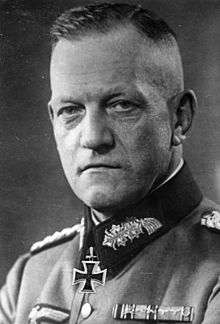Georg Lindemann
| Georg Lindemann | |
|---|---|
 | |
| Born |
8 March 1884 Osterburg, German Empire |
| Died |
25 September 1963 (aged 79) Freudenstadt, West Germany |
| Allegiance |
|
| Service/branch | Army |
| Years of service | 1903–45 |
| Rank | Generaloberst |
| Commands held |
36th Infantry Division L Army Corps 18th Army |
| Battles/wars |
World War II |
| Awards | Knight's Cross of the Iron Cross with Oak Leaves |
Georg Heinrich Lindemann (8 March 1884 – 25 September 1963) was a German Wehrmacht general during World War II. He was a recipient of the Knight's Cross of the Iron Cross with Oak Leaves, one of 890 Nazi Germany's military men to be so decorated.
World War I
Born in 1884, Georg Lindemann joined the Prussian Army and served as an officer in World War I on both the Eastern Front and the Western Front. After the war, he joined Paul von Lettow-Vorbeck's Freikorps and, during the civil unrest of 1919, helped crush the Communist Workers Council in Hamburg. With the rise of the Nazi party, Lindemann was promoted to commander of the Kriegsschule in Hanover. He occupied this position until 1936.
World War II
In 1936, Lindemann was promoted to Generalleutnant and given command of the 36th Infantry Division. The division was involved in guarding the Saar region during the Invasion of Poland, and it then took part in the Invasion of France. At the end of the Western campaign, Lindemann was promoted to Cavalry General (General der Kavallerie) and given command of the L Army Corps.
In June 1941, at the launch of Operation Barbarossa, Lindemann's Corps was a part of Army Group North. Lindemann commanded the corps during the advance towards Leningrad. His unit was briefly shifted to the command of Army Group Centre during the Battle of Smolensk. Lindemann's corps was then shifted back to Army Group North.
On 16 January 1942, Lindemann took the command of the 18th Army, a part of Army Group North. In the summer of 1942, he was promoted to Generaloberst. Lindemann commanded the 18th Army throughout the campaigns around Leningrad and during the January 1944 retreat from Oranienbaum to Narva. He was promoted to command of Army Group North on 31 March 1944. On 4 July 1944 he was relieved and transferred to the Reserve Army. On 1 February 1945, he was appointed to the command of all German troops in Denmark as the "Supreme Commander of the Armed Forces in Denmark".
On 3 May, Lindemann participated in a meeting with the OKW, the new government and the new German Head of State, Grand Admiral Karl Dönitz at the Naval Academy at Mürwik. Lindemann informed Dönitz that he would be able to hold Denmark for some time, and he and his colleague in Norway, General Franz Böhme, argued for keeping Denmark and Norway in German hands as bargaining chips in the armistice negotiations soon to come. Instead, Germany surrendered unconditionally in northwest Germany, the Netherlands, and Denmark on 5 May 1945. Lindemann was then given the task of dismantling the German occupation of Denmark until 6 June 1945, when he was arrested at his headquarters in Silkeborg. Lindemann was held in American custody until 1948. Lindemann died in 1963 in West Germany.
Awards and decorations
- Iron Cross (1914) 2nd Class (9 September 1914) & 1st Class (28 July 1915)[1]
- Clasp to the Iron Cross (1939) 2nd Class (26 September 1939) & 1st Class (30 October 1939)[1]
- Knight's Cross of the Iron Cross with Oak Leaves
- Knight's Cross on 5 August 1940 as Generalleutnant and commander of the 36. Infantry-Division[2]
- 275th Oak Leaves on 21 August 1943 as Generaloberst and commander of the 18.Armee[3]
- Order of the Cross of Liberty 1st Class with Star (29 March 1943)
- Mentioned twice in the Wehrmachtbericht (29 June 1942 and 12 August 1943)
References
Citations
Bibliography
- Fellgiebel, Walther-Peer (2000) [1986]. Die Träger des Ritterkreuzes des Eisernen Kreuzes 1939–1945 — Die Inhaber der höchsten Auszeichnung des Zweiten Weltkrieges aller Wehrmachtteile [The Bearers of the Knight's Cross of the Iron Cross 1939–1945 — The Owners of the Highest Award of the Second World War of all Wehrmacht Branches] (in German). Friedberg, Germany: Podzun-Pallas. ISBN 978-3-7909-0284-6.
- Scherzer, Veit (2007). Die Ritterkreuzträger 1939–1945 Die Inhaber des Ritterkreuzes des Eisernen Kreuzes 1939 von Heer, Luftwaffe, Kriegsmarine, Waffen-SS, Volkssturm sowie mit Deutschland verbündeter Streitkräfte nach den Unterlagen des Bundesarchives [The Knight's Cross Bearers 1939–1945 The Holders of the Knight's Cross of the Iron Cross 1939 by Army, Air Force, Navy, Waffen-SS, Volkssturm and Allied Forces with Germany According to the Documents of the Federal Archives] (in German). Jena, Germany: Scherzers Miltaer-Verlag. ISBN 978-3-938845-17-2.
- Thomas, Franz (1998). Die Eichenlaubträger 1939–1945 Band 2: L–Z [The Oak Leaves Bearers 1939–1945 Volume 2: L–Z] (in German). Osnabrück, Germany: Biblio-Verlag. ISBN 978-3-7648-2300-9.
- Die Wehrmachtberichte 1939–1945 Band 2, 1. Januar 1942 bis 31. Dezember 1943 [The Wehrmacht Reports 1939–1945 Volume 2, 1 January 1942 to 31 December 1943] (in German). München, Germany: Deutscher Taschenbuch Verlag GmbH & Co. KG. 1985. ISBN 978-3-423-05944-2.
| Military offices | ||
|---|---|---|
| Preceded by none |
Commander of 36. Infanterie-Division 1 September 1939 – 25 October 1940 |
Succeeded by Generalleutnant Otto-Ernst Ottenbacher |
| Preceded by Generalfeldmarschall Georg von Küchler |
Commander of 18. Armee 16 January 1942 – 29 March 1944 |
Succeeded by General der Artillerie Herbert Loch |
| Preceded by Generalfeldmarschall Walter Model |
Commander of Heeresgruppe Nord 31 March 1944 – 4 July 1944 |
Succeeded by Generaloberst Johannes Frießner |
